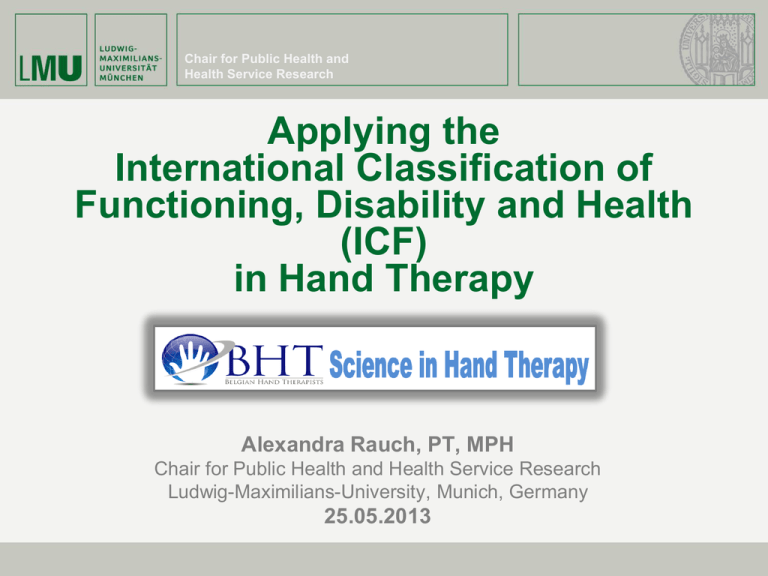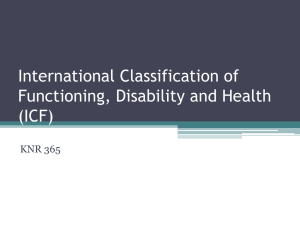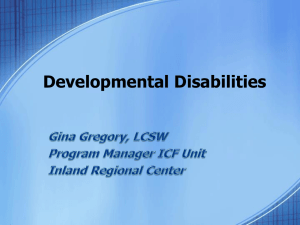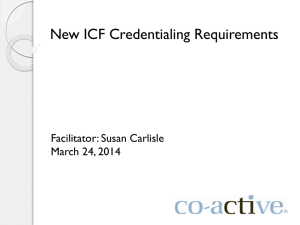ICF
advertisement

Chair for Public Health and Health Service Research Applying the International Classification of Functioning, Disability and Health (ICF) in Hand Therapy Alexandra Rauch, PT, MPH Chair for Public Health and Health Service Research Ludwig-Maximilians-University, Munich, Germany 25.05.2013 Applying the ICF in hand therapy • About the ICF • Development of ICF Core Sets • The ICF Core Sets for hand conditions – where are we now? • The ICF Core Sets for hand conditions – what is next About the ICF Hand conditions Injuries - Diseases • • • • • • • • • • • Wounds Fractures Tendon injuries Ruptures, strains and sprains of ligaments Nerv injuries Amputations Burns Allergies Carpal tunnel syndromes Complex regional pain syndrome Rhizarthrosis What do these diagnosis tell us about the lived experience of a person living with a hand condition? 3 About the ICF Health Condition (disease, trauma) Body Functions Body Structures Activities Participation Functioning - Disability Environmental Factors Personal Factors 4 About the ICF Flexor tendon injury ICD 10: S 66.1 Health Condition 14 weeks ago (disease, trauma) • Skin damage (scar) Body Functions • Reduced sensitivity •Body Decrased Structures muscle power • Reduced joint movement • Pain • Difficulties to grab and hold big or heavy objects • Difficulties with moving smallActivities objects with fingers • Difficulties to lift objects • Difficulties with washing hair and body • Difficulties with cooking and cleaning the house Environmental No assistive devices Support fromFactors daughter Physiotherapy 2/week Not able to work as goldsmith Difficulties with riding a bicycle Participation Not able to play piano Personal Factors 52 years old women, living alone Daughter and little grandchild Goldsmith, owner of jewelry store 5 Flexor tendon injury ICD 10: S 66.1 Health Condition 14 weeks ago (disease, trauma) • Skin damage (scar) • Reduced sensitivity • Decrased muscle power • Reduced joint movement • Pain • Difficulties to grab and hold big or heavy objects • Difficulties with moving small objects with fingers • Difficulties to lift objects • Difficulties with washing hair and body • Difficulties with cooking and cleaning the house Environmental No assistive devices Support fromFactors daughter Physiotherapy 2/week Not able to work as goldsmith Difficulties with riding a bicycle Not able to play piano Personal Factors 52 years old women, living alone Daughter and little grandchild Goldsmith, owner of jewelry store 6 About the ICF Health Condition (disease, trauma) Body Functions Body Structures Functioning Activities Environmental Factors Participation Disability Personal Factors 7 About the ICF Family of International Classifications (FIC) Diseases Functioning/Disability Joint use 8 About the ICF ICD Health condition ICF Body functions Body structures Activities Environmental factors Participation Personal factors About the ICF The classification Structure ICF Functioning and Disability Body functions and Structures Contextual factors Activities and Participation Environmental factors b1 – b8 s1 – b8 d1 – d9 e1 – e5 b110 b899 s110 s899 d110 d999 e110 e599 b1100 b7809 s1100 s8309 d1550 d9309 e1100 e5959 b11420 b51059 s11000 s76009 Personal factors Describing Functioning and Disability 11 About the ICF The classification Body structures Body function Activities and Participation Environmental factors Structure Chapter 1 MENTAL functions Chapter 2 SENSORY functions and PAIN Chapter 3 VOICE and SPEECH functions Chapter 4 Functions of the CARDIOVASCULAR, HAEMATOLOGICAL, IMMUNOLOGICAL and RESPIRATORY system Chapter 5 Functions of the DIGESTIVE, METABOLIC and ENDOCRINE system Chapter 6 GENITOURINARY and REPRODUCTIVE functions Chapter 7 NEUROMUSCULOSKELETAL and MOVEMENT-RELATED functions Chapter 8 Functions of the SKIN and RELATED STRUCTURES About the ICF The classification Body structures Body function Activities and Participation Environmental factors Structure Chapter 1 MENTAL functions Chapter 2 SENSORY functions and PAIN Chapter 3 VOICE and SPEECH functions Chapter 4 Functions of the CARDIOVASCULAR, HAEMATOLOGICAL, IMMUNOLOGICAL and RESPIRATORY systems Chapter 5 Functions of the DIGESTIVE, METABOLIC and ENDOCRINE SYSTEMS Chapter 6 GENITOURINARY and REPRODUCTIVE functions Chapter 7 NEUROMUSCULOSKELETAL and MOVEMENT-RELATED functions Chapter 8 Functions of the SKIN and RELATED STRUCTURES About the ICF The classification Structure Chapter 7 NEUROMUSCULOSKELETAL and MOVEMENT-RELATED functions Body structures Body function Activities and Participation Environmental factors b710 Mobility of joint functions b715 Stability of joint functions b720 Mobility of bone functions b730 Muscle power functions b735 Muscle tone functions b740 Muscle endurance functions b750 Motor reflex functions b755 Involuntary movement reaction functions b760 Control of voluntary movement functions b765 Involuntary movement functions b770 Gait pattern functions b780 Sensations related to muscles and movement functions About the ICF The classification Structure Chapter 7 NEUROMUSCULOSKELETAL AND MOVEMENT-RELATED functions Body structures Body function b735 Muscle tone functions Activities and Participation Functions related to the tension present in the resting muscles and the resistance offered when trying to move the muscles passively. Environmental factors Inclusions: functions associated with the tension of isolated muscles and muscle groups, muscles of one limb, one side of the body and the lower half of the body, muscles of all limbs, muscles of the trunk, and all muscles of the body; impairments such as hypotonia, hypertonia and muscle spasticity Exclusions: muscle power functions (b730); muscle endurance functions (b740) About the ICF The classification Structure Chapter 7 NEUROMUSCULOSKELETAL and MOVEMENT-RELATED functions 310 Body structures 493 Body function 384 Activities and Participation 253 Environmental factors b735 Muscle tone functions b7350 Tone of isolated muscles and muscle groups b7351 Tone of muscles of one limb b7352 Tone of muscles of one side of body b7353 Tone of muscles of lower half of body b7354 Tone of muscles of all limbs b7355 Tone of muscles of trunk b7356 Tone of all muscles of the body About the ICF The classification Structure specify s730 Structure of the upper extremity 310 power Body structures b730 Muscle functions 493 Body function d440 Fine hand functions 384 Activities and Participation d850 Remunerative employment Environmental factors e135 Products and technology for personal 253 use in daily life About the ICF The classification ICF Qualifier specify evaluate 0 NO problem (none, absent, negligible,...) (0-4%) 1 MILD problem (slight, low,...) (5-24%) 2 MODERATE problem (medium, fair...) (25-49%) 310 Body structures 493 Body function 384 Activities and Participation 3 SEVERE problem (high, extreme,...) (50-95%) 253 Environmental factors 4 COMPLETE problem (total,...) (96-100%) b730.3 = Severe problems in muscle power functions Flexor tendon injury ICD 10: S 66.1 Health Condition 14 weeks ago (disease, trauma) • b820.1 Repair functions of • the Skinskin damage (scar) •• Reduced b265.3 Touch funtions sensitivity •• Decrased b730.3 Muscle power muscle power functions • Reduced joint movement •• Pain b710.3 Mobility of joint functions • b280.2 Sensation of pain •• Difficulties to grab and d4401.3 Grasping hold big or heavy objects • d4402.3 Manipulating •• Difficulties with moving d4300.2 Lifting small objects with fingers • d5100.2 Washing body ••Difficulties to lift objects d630.1 Preparing • Difficulties with meals and body •washing d6402.2hair Cleaning living • Difficulties with cooking area and cleaning the house • d850.4 Remunerative Not able to work as employment goldsmith • d4750.4 Driving human Difficulties with riding a powered transportation bicycle • d9202.4 Arts and culture Not able to play piano • e1151.4 Assistive products and Personal Factors Nopersonal assistiveuse devices technology for in daily living 52 years old women, living alone Daughter and little grandchild Support daughter • e310+3 Support fromfrom family Goldsmith, owner of jewelry store Physiotherapy • e5800+1 Health services 2/week 19 Flexor tendon injury ICD 10: S 66.1 14 weeks ago 0 1 2 3 4 • • • • • • • • • • • • • • • b820.1 Repair functions of the skin b265.3 Touch funtions b730.3 Muscle power functions b710.3 Mobility of joint functions b280.2 Sensation of pain d4401.3 Grasping d4402.3 Manipulating d4300.2 Lifting d5100.2 Washing body d630.1 Preparing meals d6402.2 Cleaning living area d850.4 Remunerative employment d4750.4 Driving human powered transportation d9202.4 Arts and culture e1151.4 Assistive products and technology for personal use in daily living • e310+3 Support from family • e5800+1 Health services 20 About the ICF The classification Number of ICF categories 310 Body structures 493 Body function 384 Activities and Participation 253 Environmental factors Very comprehensive Very comprehensive ICF Qualifier Facilitates profiles Reliability? About the ICF The classification "To be useful, practical ICF based tools need to be tailored to the need of the users without forgoing the information needed for health statistics and health reporting“ 310 Body structures 493 Body function 384 Activities and Participation 253 Environmental factors Dr. Bedirhan Üstün WHO Classification Office Director Üstün B et.al. Common yet specific tools to measure clinical outcomes: ICF Comprehensive Sets and ICF Core Sets. J Rehab Med 2004; (44 suppl):7-8. Development of ICF Core Sets 310 Body structures 493 Body function 384 Activities and Participation 253 Environmental factors s110 s120 s130 s430 s510 s710 … b110 b114 b117 b130 b152 b144 b730 ... d110 d240 d410 d415 d520 d630 d920 … e110 e115 e120 e125 e130 e150 … s110 s430 s710 b110 b130 b152 b730 d240 d410 d415 d920 e110 e120 e130 Comprehensive ICF Core Set Brief ICF Core Set Development of ICF Core Sets Preliminary studies Decision Validation Empirical study (Patient data) Qualitative study International ConsensusConference (Patient interviews) Testing & Validation Expert Survey (Multiprofessional) Systematic Review ICF Core Sets (Comprehensive and Brief) (Scientific literature) TIME Development of ICF Core Sets Musculosckeletal conditions Neurological conditions Cardiopulmonary conditions Others Musculoskeletal condition in acute care Neurological conditions in acute care Cardiopulmonary conditions in acute care Diabetes mellitus Musculoskeletal condition in early postacute care Neurological conditions in early post-acute care Cardiopulmonary conditions in early post-acute care Obesity Low back pain Stroke Chronic ischaemic heart disease Inflammatory bowel diseases Chronic widespread pain Multiple sclerosis Obstructive pulmonary diseases Vertigo Osteoarthritis Spinal cord injury Hearing loss Rheumatoid arthritis Traumatic brain injury Cerebral palsy Mental disorders Sleep disorders Ankylosing spondylitis Osteoporosis Depression Hand conditions Bipolar disorders Amputation Geriatric patients Vocational rehabilitation The ICF Core Sets for hand conditions – where are we now? • Developed from 2008 to 2010 • Applicable in hand injuries and hand diseases • 117 categories in the Comprehensive ICF Core Set • 23 categories in the Brief ICF Core Set The ICF Core Sets for hand conditions – where are we now? Preliminary studies Empirical study (Patient data n=210) Qualitative study Decision International ConsensusConference (Patient interviews n=59) Expert Survey (Multiprofessional n=162 Systematic Review ICF Core Sets (Comprehensive and Brief) Validation Implementation Validation of the ICF Core Sets for Hand Conditions in Germany (Scientific literature) 2008/2009 05/2009 2010 2012-2015 Brief ICF Core Set for Hand conditions Body structures Activity and Participation s120 Structure of the spinal cord and related structures d230 Carry out daily routine s720 Structure of shoulder region d440 Fine hand functions s730 Structure of the upper extremity d445 Hand and arm use Body functions d5 Self-care b152 Emotional functions d6 Domestic life b265 Touch function d7 Interpersonal interactions and relationships b270 Sensory functions related to temperature and other stimuli d430 Lifting and carrying objects d840-d859 Remunerative employment b280 Sensation of pain b710 Mobility of joint functions Environmental factors b715 Stability of joint functions e1 Products and technology b730 Muscle power functions e3 Support and relationships b760 Control of voluntary movement functions e5 Services, systems and policies b810 Protective functions of the skin 28 Comprehensive ICF Core Set for Hand conditions Body structures s120 Structure of the spinal cord and related structures s410 Structure of cardiovascular system s710 Structure of head and neck region s720 Structure of shoulder region s730 Structure of the upper extremity s7300 Structure of upper arm s7301 Structure of forearm s7302 Structure of hand s770 Additional musculoskeletal structures related to movement s810 Structure of areas of skin s830 Structure of nails 29 Comprehensive ICF Core Set for Hand conditions Body functions b134 Sleep functions b152 Emotional functions b1801 Body image b260 Proprioceptive functions b265 Touch functions b270 Sensory functions related to temperature and other stimuli b2700 Sensitivity to temperature b2701 Sensitivity to vibration b2702 Sensitivity to pressure b2703 Sensitivity to a noxious stimulus b280 Sensation of pain b415 Blood vessel functions 30 Comprehensive ICF Core Set for Hand conditions Body functions b710 Mobility of joint functions b7100 Mobility of a single joint b7101 Mobility of several joints b715 Stability of joint functions b720 Mobility of bone functions b730 Muscle power functions b7300 Power of isolated muscles and muscle groups b7301 Power of muscles of one limb b735 Muscle tone functions b740 Muscle endurance functions b760 Control of voluntary movement functions b765 Involuntary movement functions b780 Sensations related to muscles and movement functions 31 Comprehensive ICF Core Set for Hand conditions Body functions b810 Protective functions of the skin b820 Repair functions of the skin b830 Other functions of the skin b840 Sensations related to the skin b860 Functions of nails 32 Comprehensive ICF Core Set for Hand conditions Activity and Participation d170 Writing d230 Carry out daily routine d360 Using communcation devices and techniques d410 Changing basic body positions d420 Transferring oneself d430 Lifting and carrying objects d440 Fine hand functions d4400 Picking up d4401 Grasping d4402 Manipulating d4403 Releasing d4408 Fine hand use, other specified 33 Comprehensive ICF Core Set for Hand conditions Activity and Participation d445 Hand and arm use d4450 Pulling d4451 Pushing d4452 Reaching d4453 Turning or twisting the hands or arms d4454 Throwing d4455 Catching d4458 Hand and arm use, other specified d455 Moving around d465 Moving around using equipment d470 Using transportation d475 Driving 34 Comprehensive ICF Core Set for Hand conditions Activity and Participation d5 Self-care d510 Washing oneself d520 Caring for body parts d530 Toileting d540 Dressing d550 Eating d560 Drinking d570 Looking after one´s health d6 Domestic life d620 Acquisition of goods and services d630 Preparing meals d640 Doing housework d650 Caring for household objects d660 Assisting others 35 Comprehensive ICF Core Set for Hand conditions Activity and Participation d7 Interpersonelle Interaktionen und Beziehungen d810 – d839 Education d840-d859 Work and employment d920 Recreation and leisure 36 Comprehensive ICF Core Set for Hand conditions Environmental factors e1 Products and technology e110 Products or substances for personal consumption e115 Products and technology for personal use in daily living e120 Products and technology for personal indoor and outdoor mobility and transportation e125 Products and technology for communication e130 Products and technology for education e135 Products and technology for employment e140 Products and technology for culture, recreation and sport e150 Design, construction and building products and technology of buildings for public use e155 Design, construction and building products and technology of buildings for private use e165 Assets 37 Comprehensive ICF Core Set for Hand conditions Environmental factors e225 Climate e3 Support and relationships e310 Immediate family e315 Extended family e320 Friends e325 Acquaintances, peers, colleagues, neighbours and community members e330 People in positions of authority e335 People in subordinate positions e340 Personal care providers and personal assistants e345 Strangers e355 Health professionals e360 Other professionals 38 Comprehensive ICF Core Set for Hand conditions Environmental factors e410 Individual attitudes of immediate family members e420 Individual attitudes of friends e425 Individual attitudes of acquaintances, peers, colleagues, neighbours and community members e430 Individual attitudes of people in positions of authority e440 Individual attitudes of personal care providers and personal assistants e445 Individual attitudes of strangers e450 Individual attitudes of health professionals e455 Individual attitudes of other professionals e460 Societal attitudes e465 Social norms, practices and ideologies 39 Comprehensive ICF Core Set for Hand conditions Environmental factors e5 Services, systems and policies e525 Housing services, systems and policies e530 Utilities services, systems and policies e535 Communication services, systems and policies e540 Transportation services, systems and policies e550 Legal services, systems and policies e555 Associations and organizational services, systems and policies e570 Social security services, systems and policies e575 General social support services, systems and policies e580 Health services, systems and policies e585 Education and training services, systems and policies e590 Labour and employment services, systems and policies 40 The ICF Core Sets for hand conditions – where are we now? How to implement the ICF Core Sets for hand condition in clinical practice? The ICF Core Sets for hand conditions – where are we now? ICF Core Sets - Manual for Clinical Practice Eds: J. Bickenbach, A. Cieza, A. Rauch, G. Stucki Hogrefe 2012 The ICF Core Sets for hand conditions – where are we now? The ICF Core Sets for hand condition Implementation The ICF Core Sets for hand conditions – where are we now? The ICF Core Sets for hand condition Implementation 1. Select ICF categories from the ICF Core Set for hand conditions What to measure? 1. Select appropriate measures to assess functioning How to measure? 1. Coordinate assessment Who to measure? 2. Report on functioning What to report? The ICF Core Sets for hand conditions – where are we now? The ICF Core Sets for hand condition Implementation 1. Select ICF categories from the ICF Core Set for hand conditions What to measure? The ICF Core Sets for hand conditions – where are we now? 1. Select ICF categories from the ICF Core Set for hand conditions Use categories from the Brief ICF Core Set... ... and select additional ICF categories from the Comprehensive ICF Core Set if necessary The ICF Core Sets for hand conditions – where are we now? 1. Select ICF categories from the ICF Core Set for hand conditions Brief ICF Core Set Comprehensive ICF Core Set d230 Carry out daily routine d360 Using communcation devices and techniques d430 Lifting and carrying objects d440 Fine hand functions d4400 Picking up d4402 Manipulating d445 Hand and arm use d5 Self-care d510 Washing oneself d540 Dressing d6 Domestic life d7 Interpersonal interactions and relationships The ICF Core Sets for hand conditions – where are we now? The ICF Core Sets for hand condition Implementation 2. Select appropriate measures to assess functioning How to measure? The ICF Core Sets for hand conditions – where are we now? 2. Select appropriate measures to assess functioning Patient-reported questionnaire (DASH) Questioning of the patient (patient history) Clinical examination Observation of the patient Standardized tests Technical examination (X-Ray, CT, ENG, etc.) PRQ= Patient reported questionnaire, PH=Patient history; CE=Clinical examination, TI=Technical investigation The ICF Core Sets for hand conditions – where are we now? 2. Select appropriate measures to assess functioning Systematic literature review National expert survey Survey DGUV Consensus conference ICF categories Assessment (PRQ/PH/CE/TI) 3 Body structures 14 9 Body functions 25 8 Activities and Participation 25 3 Environmental factors 15 The ICF Core Sets for hand conditions – where are we now? 2. Select appropriate measures to assess functioning Body structures ICF category s120 Structure of the spinal cord and related structures Source Specification PRQ PH CE TI s720 Structure of shoulder region s730 Structure of the upper extremity X-Ray, CT, ENG, etc. --- Circumferential measure, Volumetry / X-Ray, CT, etc. PRQ= Patient reported questionnaire, PH=Patient history; CE=Clinical examination, TI=Technical investigation The ICF Core Sets for hand conditions – where are we now? 2. Select appropriate measures to assess functioning s730 Structure of the upper extremity – Bones Technical investigation (e.g. X-Ray) s730 Structure of the upper extremity - Swallowing Circumferential measure PRQ= Patient reported questionnaire, PH=Patient history; CE=Clinical examination, TI=Technical investigation The ICF Core Sets for hand conditions – where are we now? 2. Select appropriate measures to assess functioning Body functions ICF category Source Specification PRQ PH CE TI b152 Emotional functions PHQ-9, GAD-7, IES-R / Questioning b265 Touch function Ten-Test, Object identification (Moberg Test) b270 Sensory functions related to temperature and other stimuli 2-Point-Discrimination, Pinprick, Cold-WarmDiscrimination b280 Sensation of pain Numeric Rating Scale Stability-Tests Observation, Purdue Pegboard Test b710 Mobility of joint functions b715 Stability of joint functions b730 Muscle power functions b760 Control of voluntary movement functions Goniometer, Finger-nailTable-Distance, FingertipPalmar-Distance Dynamometer, Pinch gauge The ICF Core Sets for hand conditions – where are we now? 2. Select appropriate measures to assess functioning b265 Touch functions Object identification (Moberg Test) b280 Sensation of pain NRS Scale b730 Muscle power functions Dynamometer PRQ= Patient reported questionnaire, PH=Patient history; CE=Clinical examination, TI=Technical investigation The ICF Core Sets for hand conditions – where are we now? 2. Select appropriate measures to assess functioning Activities and participation ICF category Source Specification PRQ PH CE TI Questioning d440 Fine hand functions DASH items 2, 3 / Pick up Test (Moberg Test) d445 Hand and arm use Observation, Selected tests from EFC d5 Self-care DASH items 13, 14, 15 d7 Interpersonal interactions and relationships d840-d859 Remunerative employment DASH Work module / Work profile, EFC d230 Carry out daily routine d430 Lifting and carrying objects d6 Domestic life Observation, Selected tests from EFC DASH items 4, 7, 8, 9 Questioning PRQ= Patient reported questionnaire, PH=Patient history; CE=Clinical examination, TI=Technical investigation The ICF Core Sets for hand conditions – where are we now? 2. Select appropriate measures to assess functioning d440 Fine hand functions Pick up test (Moberg Test) d445 Hand and arm use Evaluation functional capacity Mild difficulty Moderate difficulty Severe difficulty Unable 13 Wash or blow dry your hair 1 2 3 4 5 14 Wash your back 1 2 3 4 5 15 Put on a pullover sweater 1 2 3 4 5 DASH Item DASH items Please rate your ability to do the following activities in the last week by circling the number below the appropriate response. No difficultiy d5 Self-care PRQ= Patient reported questionnaire, PH=Patient history; CE=Clinical examination, TI=Technical investigation The ICF Core Sets for hand conditions – where are we now? 2. Select appropriate measures to assess functioning Environmental factors ICF category e1 Products and technology e3 Support and relationships e5 Services, systems and policies Source Specification PRQ PH CE TI Questioning Questioning Questioning PRQ= Patient reported questionnaire, PH=Patient history; CE=Clinical examination, TI=Technical investigation The ICF Core Sets for hand conditions – where are we now? 2. Select appropriate measures to assess functioning e1 Products and technology Questioning e3 Support and relationships Questioning PRQ= Patient reported questionnaire, PH=Patient history; CE=Clinical examination, TI=Technical investigation The ICF Core Sets for hand conditions – where are we now? The ICF Core Sets for hand condition 3. Coordinate assessment Who to measure? Implementation The ICF Core Sets for hand conditions – where are we now? 3. Coordinate assessment Create intervention table: ICF category Assessment Responsibility s730 Structure of the upper extremity X-Ray MD b152 Emotional functions Questioning, PRQ MD, Psychologist b270 Sensory functions related to temperature and other stimuli 2-Point-Discrimination, Pin-prick, Cold-WarmDiscrimination MD b710 Mobility of joint functions Goniometer, Pinch Gauge PT/OT d440 Fine hand functions Pick up test PT/OT e3 Support and relationships Questioning MD The ICF Core Sets for hand conditions – where are we now? The ICF Core Sets for hand condition 4. Report on functioning What to report? Implementation The ICF Core Sets for hand conditions – where are we now? 4. Report on functioning The ICF Core Sets for hand conditions – where are we now? www.icf-casestudies.org The ICF Core Sets for hand conditions – where are we now? http://www.icf-core-sets.org/index.php The ICF Core Sets for hand conditions – what is next? The ICF Core Sets for hand conditions – what is next? Development of functioning scores 0 problem 10 20 Functioning No 30 40 50 60 70 80 90 Disability 100 Complete problem Cieza A et al. The International Classification of Functioning, Disability, and Health could be used to measure functioning. J Clin Epidemiol 2009; 62: 899-911 Grill E et al. Scales could be developed based on simple clinical ratings of ICF Core Set categories. J Clin Epidemiol 2009; 62: 891-898 The ICF Core Sets for hand conditions – what is next? Which ICF Categories should be included in a functioning score? b110 Consciousness functions b210 Seeing functions b310 Vice functions b410 Heart functions b510 Ingestion functions b610 Urinary excretory functions b710 Mobility of joint functions b810 Protective functions of the skin … Body functions s110 Structure of brain s210 Structure of eye socket s310 Structure of nose s410 Structure of cardiovascular system s510 Structure of salivary glands s610 Structure of urinary system s710 Structure of head and neck region s810 Structure of areas of skin … Body structures d110 Watching d210 Undertaking simple tasks d310 Communicating with –receiving – spoken messages d410 Changing basic body positions d510 Washing oneself d610 Acquiring a place to live d710 Basic interpersonal interactions d810 Informal education … Activity & Participation Method The ICF Core Sets for hand conditions – what is next? Method: Identify ICF categories that explain functioning! Example: What explains functioning in persons with spinal cord injury Example: d525 Defecation functions = good fitting The ICF Core Sets for hand conditions – what is next? Method: Identify ICF categories that explain functioning! Example: What explains functioning in persons with spinal cord injury Example: d550 Eating = poor fitting The ICF Core Sets for hand conditions – what is next? Functioning score 0 10 20 30 40 50 60 Disability 70 80 90 100 Cieza A et al. The International Classification of Functioning, Disability, and Health could be used to measure functioning. J Clin Epidemiol 2009; 62: 899-911 The ICF Core Sets for hand conditions – what is next? „Translate“ assessment results 0 0 10 1 20 30 40 2 50 60 70 3 80 90 100 4 The ICF Core Sets for hand conditions – what is next? 0 NO problem (none, absent, negligible,...) 1 (5-24%) MILD problem (slight, low,...) 2 (25-49%) MODERATE problem (medium, fair...) 3 (50-95%) SEVERE problem (high, extreme,...) 4 (96-100%) COMPLETE problem (total,...) 10 0 (0-4%) 20 30 40 50 60 70 80 90 100 Cieza A et al. Items from patient-oriented instruments can be integrated into interval scales to operationalize categories of the ICF . J Clin Epidemiol 2009; 62: 912-921 The ICF Core Sets for hand conditions – what is next? Which ICF Categories should be included in a disability score? b110 Consciousness functions b210 Seeing functions b310 Vice functions b410 Heart functions b510 Ingestion functions b610 Urinary excretory functions b710 Mobility of joint functions b810 Protective functions of the skin … Body functions s110 Structure of brain s210 Structure of eye socket s310 Structure of nose s410 Structure of cardiovascular system s510 Structure of salivary glands s610 Structure of urinary system s710 Structure of head and neck region s810 Structure of areas of skin … Body structures d110 Watching d210 Undertaking simple tasks d310 Communicating with –receiving – spoken messages d410 Changing basic body positions d510 Washing oneself d610 Acquiring a place to live d710 Basic interpersonal interactions d810 Informal education … Activity & Participation Purpose driven: Ministry level Service provision level Professional level Flexor tendon injury ICD 10: S 66.1 14 weeks ago 0 1 2 3 4 •b265.3 Touch funtions • b730.3 Muscle power functions • b710.3 Mobility of joint functions • b280.2 Sensation of pain • d440.3 Fine hand function • d4300.2 Hand and arm use • d630.1 Preparing meals • d850.4 Remunerative employment • d4750.4 Driving human powered transportation 0 10 20 30 40 50 60 Functioning 70 80 90 100 79 The ICF Core Sets for hand conditions – what is next? Service provision level Purpose: b110 Consciousness functions b210 Seeing functions b310 Vice functions b410 Heart functions b510 Ingestion functions b610 Urinary excretory functions b710 Mobility of joint functions b810 Protective functions of the skin … Body functions s110 Structure of brain s210 Structure of eye socket s310 Structure of nose s410 Structure of cardiovascular system s510 Structure of salivary glands s610 Structure of urinary system s710 Structure of head and neck region s810 Structure of areas of skin … Body structures d110 Watching d210 Undertaking simple tasks d310 Communicating with –receiving – spoken messages d410 Changing basic body positions d510 Washing oneself d610 Acquiring a place to live d710 Basic interpersonal interactions d810 Informal education … Activity & Participation To monitor service provision Health condition specific Selection from health condition specific ICF Core Sets Flexor tendon injury ICD 10: S 66.1 14 weeks ago 0 • • • • • • • • • • • 1 2 3 4 b820.1 Repair functions of the skin b265.3 Touch funtions b730.3 Muscle power functions b710.3 Mobility of joint functions b280.2 Sensation of pain 0 10 0 10 20 30 40 50 60 70 80 90 100 20 30 40 50 60 70 80 90 100 Body functions and structures d4401.3 Grasping d4402.3 Manipulating d4300.2 Lifting d5100.2 Washing body d630.1 Preparing meals d6402.2 Cleaning living area • d850.4 Remunerative employment • d4750.4 Driving human powered transportation • d9202.4 Arts and culture Activities and Participation 81 The ICF Core Sets for hand conditions – what is next? Professional level Purpose: Body functions Body structures Mobility Body functions Body structures Body functions Activity & Participation Body structures Employment To measure functioning in relation to intervention goals Activity & Participation Self-care Health condition specific Activity & Participation Body functions Body structures Social life Activity & Participation Body functions Body structures Education Activity & Participation From health condition specific ICF Core Sets Thank you very much for your attention! alexandra.rauch@med.uni-muenchen.de






